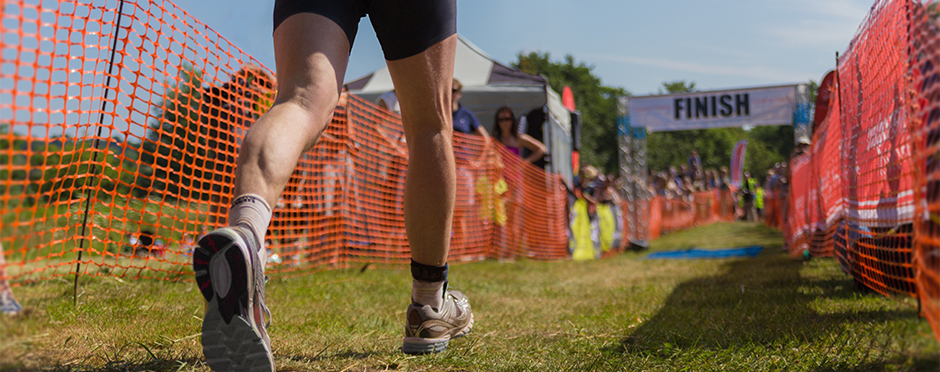
5 Ways to Maximize Triathlon Performance
Leave a CommentParticipation in triathlons in the United States is at an all-time high according to USA Triathlon, the sport’s governing body in the United States. The group’s membership has swelled from around 100,000 in 1998 to 550,446 in 2013.1 What’s more, estimates from the Sports and Fitness Industry Associated show there were 2,498,000 road triathletes in the United States in 2016.2
With the number of participants in triathlon races increasing, it is important to have a training plan in order to prevent injury and maximize performance on race day. There are numerous training plans and philosophies available to follow, but many are missing valuable components that can improve performance and decrease the risk of injury. Read below for five things to include in your training program in order to maximize triathlon performance.
1. Bicycle Fitting
Bicycles should be comfortable and fitted into a position that maximizes force output. There are multiple variables including saddle height, stem height and handlebar height that should be taken into consideration. Small changes in position on the bicycle can lead to large changes in muscle efficiency, which can help athletes maximize speed with less energy. For help with bike set up, athletes can seek out assistance from a local bicycle store or certified triathlon coach.
2. Running Form
Although most triathlon plans will include weekly running, few address proper form and how to run more efficiently to decrease force applied to the joints. Research shows that increasing cadence, or the number of steps taken, can decrease loading on the foot, knee and hip – which may lead to less overuse injuries.3 An easy way to track cadence is by using a metronome smartphone app. These apps can help to determine current steps per minute, and athletes can use this as a benchmark to start increasing their steps in 5 percent increments up to 170-190 steps per minute.
Another way to improve running form is by using Video Gait Analysis (VGA). This service can be used to analyze running under slow motion in order to identify areas of improvement that can help to prevent injuries and maximize performance. Physical therapists at Athletico Physical therapy are qualified to perform VGA and work with athletes to create plans for more efficient running through training and on race day.
3. Joint Mobility
Swimming, bicycling and running all utilize joints differently. Most training plans will outline the importance of stretching, but few people follow those recommendations. An easy way to prepare your joints for training is by utilizing a dynamic warm up to prepare the body for training. Learn more about the difference between stretching and a dynamic warm up by reading Athletico’s “Stretching Vs. Warming Up: What’s the Difference?”
4. Strength Training
A deficit in many triathlon training programs is the absence of strength training. Most programs include swimming, biking and running, but end up omitting ways to maintain or improve strength. The goal should not be to increase muscle size but rather to maintain strength to allow for maximum performance while training. Including bodyweight squats, lunges, planks and gluteal muscle strength is a great way to build a resilient body to prevent injuries while training.
5. Body Awareness
Triathlon training requires a large commitment in time and physical capacity. Being aware of when aches and pains are becoming injuries is vital to maximizing performance. Understanding of when to recover and when to push through aches is important to maximizing performance on race day. Physical therapists at Athletico are experts in musculoskeletal injuries and are available for a free assessment to determine the best plan to prevent/treat injuries and maximize overall performance.
The Athletico blog is an educational resource written by Athletico employees. Athletico bloggers are licensed professionals who abide by the code of ethics outlined by their respective professional associations. The content published in blog posts represents the opinion of the individual author based on their expertise and experience. The content provided in this blog is for informational purposes only, does not constitute medical advice and should not be relied on for making personal health decisions.
References:
1. “Triathlons Grow In Popularity; Participation Reaches All-Time High.” The Huffington Post. TheHuffingtonPost.com, 29 July 2013. Web. 11 Apr. 2017. <http://www.huffingtonpost.com/2013/07/29/triathlons-popularity-participant-all-time-high_n_3670543.html>.
2. “Triathlon (Traditional/Road) Participation Report 2016.” Sports & Fitness Industry Association. SFIA, 2016. Web. 8 Apr. 2017. <https://www.sfia.org/reports/435_Triathlon-%28Traditional-Road%29-Participation-Report-2016>.
3. Winter, S., S. Gordon, and K. Watt. “Effects of Fatigue on Kinematics and Kinetics during Overground Running: A Systematic Review.”J Sports Med Phys Fitness(2016): n. pag. gov. Web.
